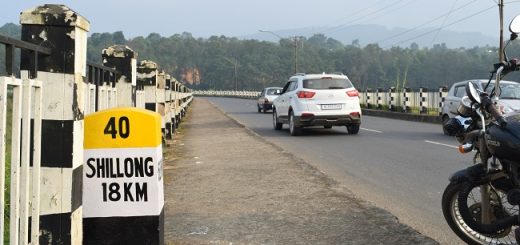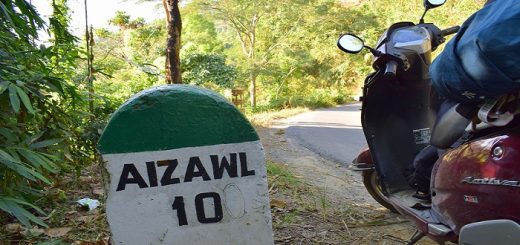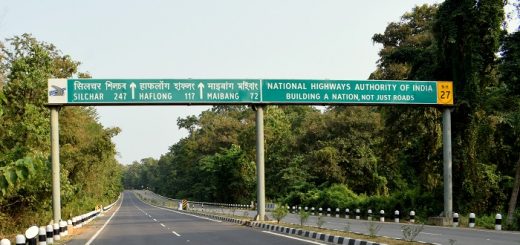Trek To Double-Decker Root Bridge In Cherrapunjee: Day Three In Meghalaya
Welcome to day three of my travelogue of North-East India, if you have read my previous articles you would know that I was traveling in Meghalaya. In the last two days, I covered some of the famous places to see in Cherrapunjee like Wei-Saw-Dong Waterfall, Arwah caves, and Noh-Ka-Likai Falls. Today’s day was special because I was going for the trek to the double root bridge in Cherrapunjee. The double root bridge is one of the most famous tourist destinations in Meghalaya, and travelers might miss a place or two while exploring Cherrapunjee, but they will never miss visiting the double root bridge. Following the same steps, I also decided to t
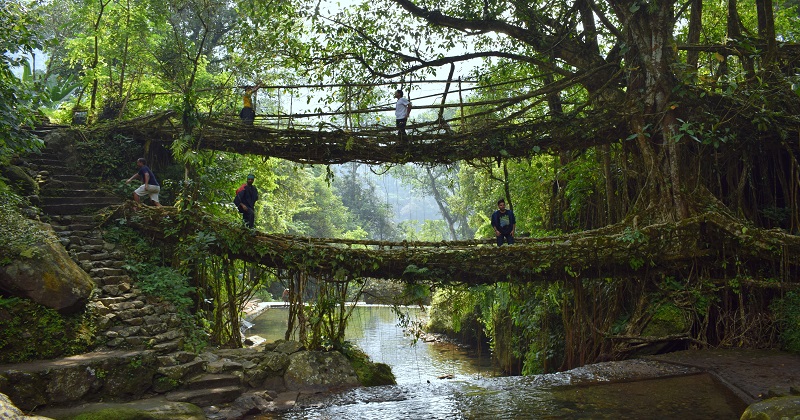
Moreover, he also informed me that there is a trek from Rainbow Waterfall that goes up to the base of Noh-Ka-Likai Falls, but it will take a lot of effort plus a day trek, and a guide. The trail goes through dense forest, and only locals are aware of the path to the Noh-Ka-Likai Falls from Rainbow Waterfall. So my today’s plan comprises Trek to Double Root Bridge, Trek to Rainbow Waterfalls and finally if I have enough time and strength, trek to the Noh-Ka-Likai Falls. In this article, I will be sharing my experience of the trek to double root bridge, and Rainbow Waterfalls, accommodation information at double root bridge, network connectivity and other do’s and don’ts to keep in mind while trekking the Double Root Bridge of in Meghalaya.
Qucik Navigate:
What is a Root Bridge and How they are formed?
The root bridge can be formed naturally as well as guided by men. Roots of rubber fig trees are used to build the most common root bridges, and this practice is most common in the Khasi and Jaintia Hills and carries out from generations by local tribes. The root bridge is formed by guiding the roots of the rubber tree and often tangling and twisting them so that they can grow and strengthen over time. Sometimes scaffolding is used to provide external support to the roots so that they are capable of holding the human weight. The bridge formed by the roots easily holds the human weight, and the bridge remains healthy until the tree is healthy. The bridge naturally self renew and rejuvenate itself. Scaffolding can be in the form of Bamboo trees or wires as per the need and area. If the bridge to be created is small, bamboo trees provide the best support, but if the bridge needs to be longer for crossing a stream, then wooden planks and ropes are also used for strengthening it.
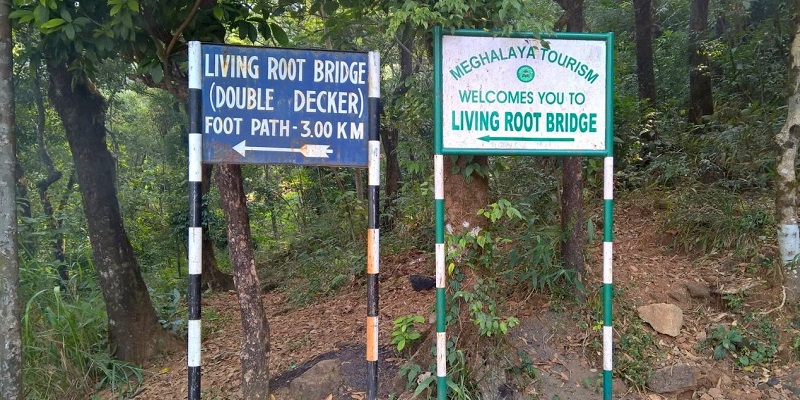
Where in India Root Bridge is Found?
The root bridge is most commonly found in the state of Meghalaya, and it is one of the major tourist attractions of the state. Apart from Meghalaya, the root bridge is also found in the state of Nagaland, but not as popular as of Meghalaya. In Meghalaya, the root bridge is found in the Khasi, and Jaintia Hills and many villages in these hills have root bridge, but three root bridges form the center of attraction. These bridges include The Double Root Bridge in Nongriat, Sigle Root Bridge in Nongriat and Living Root Bridge in Mawlynnong, Pynursla. Out of these three, the Living Root Bridge in Pynursla is the longest root bridge while the Double Decker root bridge in Nongriat is the most famous.
My Trek To Double Root Bridge in Nongriat
Last night I discussed with my homestay owner, and he provided me every information related to the trek to the double root bridge. He updated me about the trek complexity as well as food and stay options in Nongriat. He also arranged a guide for me in case I was willing to trek further to the base of the Noh-Ka-Likai falls and guide agreed on INR 1500. Initially, I was reluctant to do the complete trek, but it has two problems. One, I had to drop my bike at the homestay and hire a public/private vehicle as my entry, and exit point will be different, which would cost me an extra 1000 rupees. Second, it was going to be a tough trek as it would take the entire day. I had no issue with the trek but knowing I had to ride the bike the next day, I thought of giving rest to my legs and not putting too much pressure. Keeping these factors in mind, I decided to trek to the Double root bridge and then to Rainbow Falls and dropped my plan to further hike to Noh-Ka-Likai Falls.

Nongriat village lies in Tyrna, and it is around 15 kilometers from the Cherrapunjee town. The road in the Cherrapunjee town is good but as Tyrna starts approaching the condition of road starts deteriorating. It took 30 minutes for me to reach the parking of Tyrna village from where the trek to the Double root bridge and single root bridge starts. The parking area has a few small shops where one can purchase items like chocolates, water bottles, bamboo sticks, etc. I was carrying a small backpack and thought it would be wise to bring only the camera bag and drop the rest of the stuff at the shop. The boy at the shop charged 50 rupees for taking care of my bag till the time I complete my trek. With only a camera bag in hand, I was feeling much lighter and started my trek. As per the locals, to reach the Double Decker Bridge one has to descend 3500 stairs and it excludes the walking in between the stairs and other bridges. Since to reach the root bridge, I had to descend and not ascend; it looked like a piece of cake. I knew while returning it is going to be one hell of a task, but it was something to be concerned later. From the top, I can see thousands of stairs going down, and it looked like these stairs will lead to the earth’s crust. One thing to keep in mind while descending a trek is to maintain the balance as gravity will be pushing down.
In most of the patches, the tourism department has constructed handrail for support yet I was keeping extra precaution. After a 30 minute trek, I reached a small village compound with small shops. From here the path divides into two-part, one goes to Double Decker Bridge and the second goes to the single root bridge. Since the double-decker bridge is the main attraction of the area, I decided to visit it first and visit the single root bridge while returning. The trek to double-decker bridge is one of the most adventurous treks a traveler can undertake. The trail passes through dense forest, villages, stairs, and water streams. The route has a couple of bridges built over the river/stream flowing nearby and walking on those bridges was an adventure in itself. Finally, after a further trek of one hour and thirty minutes, I reached another village with a signboard showing the direction of the double-decker bridge. Knowing that the root bridge is a few hundred meters more, I was filled with excitement and soon reached the entrance/ticket point of the double-decker bridge.
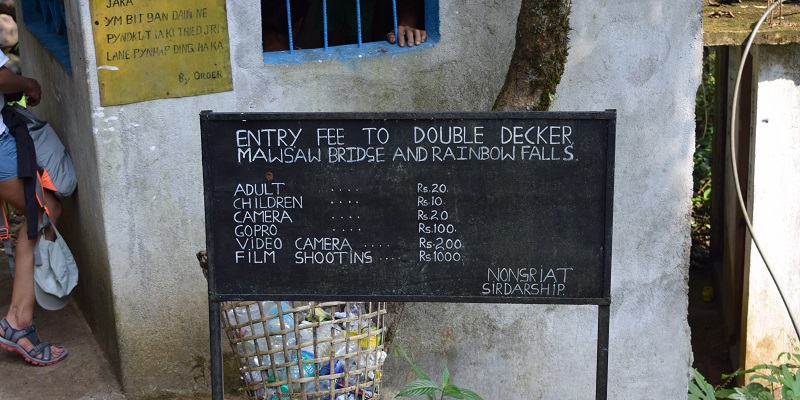
One thing that I noticed while traveling in Meghalaya was that here people are much more aware of Drones and GoPro. In almost all the tourist points they have specially mentioned a separate charge for GoPro and Drone. While in the rest of India, there is no specific price for GoPro and drones are either prohibited or requires a lengthy approval process. After paying the entry fees for Camera, I reached the double-decker bridge and was amazed by its construction. Though the bridge was not long, the way it was spanning from one tree to another was spectacular. Two bridges running parallel to each other and made up of roots; it was something I witnessed for the first time. I went close to the tree to see how the bridge was formed, and it looked like roots were braided with each other like a girl’s hair. Many new roots were coming out from its base and were guided back to the bridge to strengthen it further. I went for a walk on the bridge, saw how the roots were tied to form one single deck. Local people have placed a wooden plank on its entire length to reduce the direct weight on the bridge. It looked like a sensible decision as the bridge is the main attraction of the area and directly and indirectly, provides a livelihood to a lot of people. Any harm to the bridge will directly impact the earning of the local people. There is a small pond near to the bridge and rocks give a shape of a waterfall. Since I was visiting in October, the pond has sufficient water, but it gave me the impression that it might get dried up during the summer season.
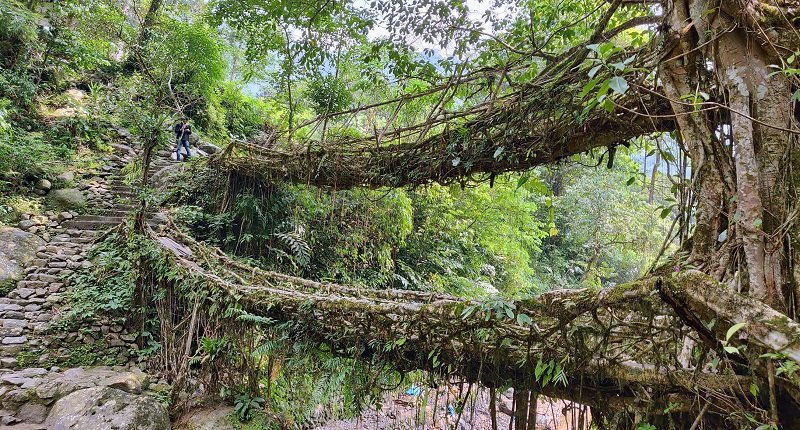
There are a few shops nearby to the bridge, and I went to a shop operated by women with her children, helping her in every possible way. I was not sure if they go to school but then climbing 3500 steps every day to go school requires a lot of dedication. People living in these areas have adapted themselves according to nature and topography and gave the impression that India is not what we see in metro cities, but real India lies in villages. Anyways, I had a heavy breakfast in the morning, and I was not in a mood to stop until I return the point I started my trek. Since I had already dropped the plan of hiking to the Noh-Ka-Likai Falls, I aimed to return Tyrna by 4 PM. I reached the double-decker bridge around 11 AM and stayed there for about 30 minutes, clicked photos, shot video, and had a tea. After spending a considerable amount of time, I moved to trek the Rainbow Falls.
Return From Double Root Bridge
I left the double-decker bridge at 11:30 AM and took another one hour to reach Rainbow waterfalls. I stayed at the Rainbow waterfall for around one hour and then started returning. While returning, I took another 45 minutes to reach the double-decker bridge and again clicked a few more pictures. I knew that no matter how many photos I click, they can’t explain what I saw with my eyes. I went for another tea break at the same shop where I had tea when I reached the double-decker bridge and started returning from the double-decker bridge by 2:30 PM. My calculation said that I would take a minimum of 2 hours to reach the starting point as while returning, I won’t be spending time taking photos, but the climbing 3500 stairs will be a challenge. On my return journey, I saw a few groups and individuals going towards the double-decker bridge, and I assumed they would be staying around the double root bridge in the night. It looked like a wise decision to me as by evening the area will have 1/4 of the crowd it had during the day. Anyways I was not in a position to do so as I had already completed half of the return journey and I was running tight on schedule. If anyone is planning for the double-decker bridge, I will recommend staying there at night.
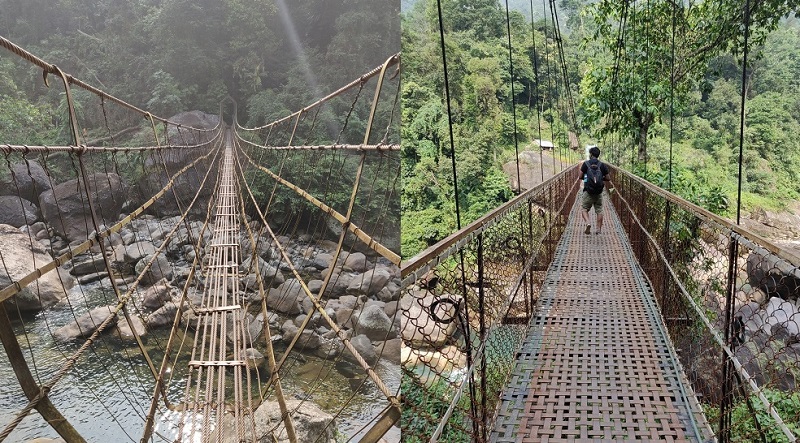
After one hour and thirty minutes of climbing, I reached the bridge where I crossed the stream, and I knew I had made it to the half-way mark. From the bridge, the real climb began, and now I can see stairs going only upward and no falt path or stairs going down. I started taking breaks after every ten or fifteen minutes of the climb as I was exhausted. After another 15 minutes of the trek and I reached the point from where the path splits into two, and in the morning, I took the one leading to double root bridge. Now it was my turn to visit the single root bridge. A 10 min of a walk (not trek) and I reached the entrance of the single root bridge. The place looked deserted as I was the only one at the entrance gate. Again I paid the fees for visiting the bridge and turned off my camera and GoPro as I was not in the mood to pay extra amount for the camera. I clicked a few photos from my phone and then walked on the bridge to see how it formed. The single root bridge is longer when compared with the double-decker bridge. The bridge spans over a broader water stream in comparison to the double-decker which spans over a small pond. When I started returning, I saw a couple visiting the bridge, and then two more girls arrived. They told me that they lost their way to the deck and were frightened, thinking they missed the entire trail. Since I had completed my trek and I was returning, I guided them what needs to be done in case they get confused and offered my water bottle.
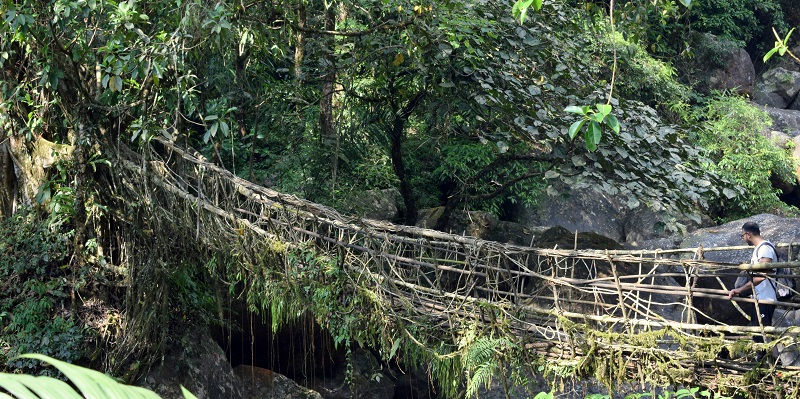
By the time I completed the single root bridge, it was 4:15 PM, and I had still some 500-600 stairs to climb. I started climbing again and took another 20-30 minutes to reach the starting point of the Double-Decker Bridge. Once I arrived there, I took a rest for around 15 minutes, ordered a maggie, and paid 50 rupees to the boy who took care of my bag. I started driving for my homestay at 4:30 PM, and in the next 30 minutes, I was at my homestay. I went straight to my room as my body and especially legs were in dire need of rest. In the night, our homestay owner again arranged bonfire for all the guests and I had a good discussion about the trek and today’s trip with fellow guests. I went for early sleep as tomorrow I planned to ride to Dawki, visiting the cleanest village in Asia, i.e., Mawlynnong and visiting the India-Bangladesh Border. I bid farewell to guests with whom I had a good interaction from the last three days and wished good luck to uncle embarking his solo journey to Meghalaya.
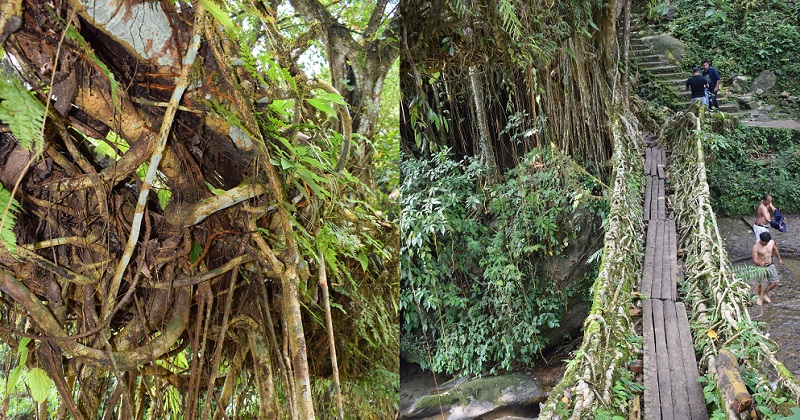
The Complexity of Double Root Bridge Trek
The trek to the Double root bridge is moderate and can be completed in 4 hours. I took 15 minutes to visit the single root bridge and including tea and photography break; one should finish it under 5 hours. If you are also planning to visit Rainbow falls, then add two more hours in your trek window. The trek can be done by any person fit enough to walk, and the problem arises while returning as one has to ascend 3500 stairs. One more thing to remember is there is no mule or potter service available for double-decker bridge as in the case of most of the commercial treks in India. Therefore try venturing when you think you are fit enough to climb 4000 stairs.
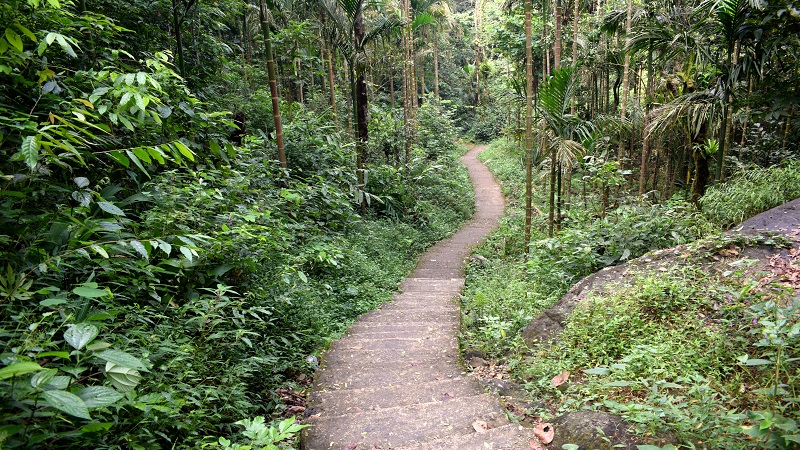
Accommodation In Double Root Bridge and Nongriat
Accommodation is readily available in the area. CHerrapunjee is only 15Km from the trek point, and the town has plenty of accommodation. I was not aware of homestays’ availability in the Nongriat village. When the double-decker bridge was a few hundred meters, I saw a lot of houses painted with information about room availability. Though there is less chance of finding a fancy hotel or homestay, if you are looking for something local and traditional Nongriat village won’t disappoint you. I will strongly recommend spending a night in Nongriat village to have a different experience. I missed it as I was not aware of the accommodation in the area. Moreover, a night stay in Nongriat will save a substantial amount of time the next day.

Availability of Food, Network Connectivity, and Other Amenities Near Double Root Bridge
As mentioned above, Cherrapunjee is one of the most visited towns in Meghalaya and north-east India. Therefore, there is hardly anything you will not find in the city. Its proximity to the state capital makes the availability of goods further easy. In the case of Nongriat village, you will find all the necessary amenities. There are small shops at a frequent distance where you can get food, chocolates, water, etc.
Regarding network connectivity, network connectivity is excellent throughout the state, and Jio works perfectly. After crossing the double-decker bridge, I was getting a 4G signal on my phone with Vodafone SIM. In a few stretches of the trek, I encountered no signal, but for most of the trek, the signal was excellent. I was getting Whatsapp messages, and I was able to call my friend. Petrol is readily available in the city, and moreover, no one is going to ride in the wilderness like Ladakh, so petrol is no concern. In case you need additional help in preparing the itinerary do let me know, and I would try my best to help you out.

